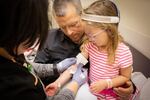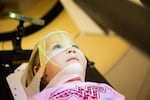The sound of toes prancing and the sight of tutus fluttering filled the studio on a frigid February afternoon at Columbia Gorge Dance Academy in Hood River. Dancers in little pink ballet shoes lined up one after another as teacher Nancy Clement began her Tuesday class for 4-year-olds.
Vivian Rose Weaver strolled in late. The blonde haired and blue-eyed girl put up a fit when her parents tried to get her dressed before class.
Vivian has difficulty walking and it had worsened within the last couple of months.
Clement modifies the class to accommodate Vivian’s needs, including grabbing her hand as the class speeds up.
Vivian is one of the 200-400 children between the ages of 4-11 with diffuse intrinsic pontine glioma, or DIPG. DIPG is a tumor located on a portion of the brainstem called the pons. Its location makes it impossible to remove with surgery. Most children with DIPG are given 9-12 months to live on average.
The causes of DIPG remain unknown and treatment options are limited.
Vivian continues to fight after more than a year with DIPG. Doctors and researchers are hopeful additional research and clinical trials will turn up more options for children like her.
An Unmistakable Appearance
Vivian’s parents, Katie and Simon Weaver, learned of their daughter’s diagnosis after she presented symptoms in January of last year.
Vivian was riding her child-sized electric four-wheeler outside their Husum, Washington, home when Simon noticed something was off. Vivian complained of a headache that seemed to pass within minutes.
Vivian had been experiencing headaches for some time, but they hadn’t phased her parents.
Around five months before, one of Vivian’s eyes began to deviate inward. A pediatric ophthalmologist examined her eyes and diagnosed strabismus, the most common eye deviation in children that most outgrow.
Simon, an ER physician, later started to put pieces together. The headaches coupled with the eye deviation and a facial nerve palsy prompted the Weavers to schedule a rushed MRI for Vivian.
Vivian's pons, the communication center of the brainstem, appeared uniformly bright and larger than usual on her MRI, an unmistakable indication of DIPG.
On Feb. 1, 2018, the day Vivian was diagnosed, life for the Weaver family changed.
“We wake up every morning and it's like this nightmare that never ends,” Katie said. “This weight that’s on us, on me, every single day. Knowing that we will try and try and try to help save Vivian, but the likelihood of that happening is more than narrow.”
Following The Course of Treatment
Upon diagnosis, Katie and Simon were told to “go home and make as good of memories” as they could.
Less than 10% of children with DIPG survive two years following diagnosis.
Radiation therapy is the only known treatment to have any effect on the disease. Temporary shrinkage of the tumor often relieves pressure on functions of the brainstem.
After radiation, all that is left are experimental options, which have little to no data to support their effectiveness. One reason for this is insufficient funding for pediatric cancer research generally and for DIPG research specifically. Just 4% of federal funding for cancer research goes toward pediatric cancers.
In the past 40 years, none of the more than 250 clinical trials for DIPG have shown improvements in chances of survival.

Simon Weaver holds his daughter, Vivian, while a nurse prepares to draw blood on Jan. 30, 2019.
Moriah Ratner / OPB
The Weavers, both medical professionals, have researched a myriad of options to save their daughter’s life. They’ve even tried some alternative therapies in hopes of contributing to the greater understanding of DIPG and its possible treatments.
The Drive To Fight
Princess costumes hang high on the wall outside Katie and Simon’s bedroom. Inside charging is the Nativis Voyager, an experimental headgear device that Vivian wears.
Vivian is the first patient with DIPG — and the first pediatric patient in the world — to use the Voyager. The headband-like device emits ultra-low frequency waves. The electric impulses mimic chemotherapeutic actions without the invasive nature of side effects, which, theoretically, may prevent tumor growth, but the device’s effectiveness for managing DIPG is yet unproven.
“We continue to employ a number of different approaches, all of which are experimental,” said Simon, “with the hope that it does something and with the hope that the knowledge we gain from trying those things might help other kids.”
'A Heavy Weight To Carry'
Vivian’s routine had become a slew of appointments and waiting rooms in the year since her diagnosis.
On Jan. 30, 2019, Vivian unsteadily roamed the halls of Oregon Health and Science University in Portland entirely decked out in pink, hand in hand with her father. Simon had noticed a change in Vivian’s speech patterns as her words began to slur together.
“And on that day it became very clear that the tumor was growing again,” said Dr. Kellie Nazemi, Vivian’s pediatric neuro-oncologist at OHSU Doernbecher Children’s Hospital.
The news that Vivian’s tumor had grown since December wasn’t a huge surprise to Katie, who knew that Vivian’s worsened balance likely signified progression.
“It's certainly a really heavy weight to carry and to bring to a family and to put on their shoulders,” Nazemi continued. “… And it's a tremendous responsibility.”

Vivian Rose Weaver continues to sit still after technicians made her radiation mask at OHSU on Feb. 4, 2019, in Portland, Ore.
Moriah Ratner / OPB
The next move for Vivian was to undergo a second course of radiation to control her symptoms.
This is a new development in DIPG treatment from the past couple of years. Doctors are now willing to go beyond the previous maximum amount of radiation in dire situations such as DIPG progression.
“Getting that much radiation in one place in your body is not good,” Simon said. “It will cause cancers if you lived long enough and the daunting acknowledgment is that none of these kids are going to live long enough to see the cancers develop from that amount of radiation.”
Using Play As An Approach To Healing
A big trampoline sits beneath a towering ring of trees outside of the Weaver home. What once embodied endless entertainment gradually became a sight of fear for Vivian. Her left leg isn't strong enough to support herself anymore, robbing Vivian from her favorite outdoor activities. Now, her interests may reflect only what she is physically capable of doing.
Despite impairments brought on by tumor progression, Vivian has made significant physical improvements with the help of Annette Broddie. Broddie is an occupational therapist and owner of KidSense Pediatric Therapy Center in Hood River and aims to help children overcome obstacles to daily functionality.
“I have treated children with cancer before, but not DIPG, so this was very different,” Broddie said.
Broddie works with Vivian on motor skills to improve her gait, balance and depth perception.
“She’s a kid,” Broddie said. “Her roles right now are to play and learn.”
Whether it’s stringing beads on a pipe cleaner to strengthen ocular motor skills or stepping on stones through a low-level obstacle course to get to Unicorn Island, Broddie believes having game-like activities will engage and motivate kids in their challenge.
Keeping Up With Traditions
Vivian’s diagnosis uprooted the Weavers’ daily regimen. They travel across the map for doctor’s appointments in Portland, therapy in Hood River, and even to Spain for treatment.
But they won’t let go of their traditions.
Ever since she was a year old, Simon has taken Vivian to Young Life’s Father Daughter Dance in Hood River.
This February was Vivian’s third time. Katie helped Vivian put on her pink dress and pulled her hair back into a tight ballerina bun topped with a tiara. Some strands of hair hadn’t yet grown back and hung loose on the back of her neck.
Vivian always picks out Simon’s tie. This year it was gray with blue stripes.
Katie and Simon cherish the time they spend with Vivian and her younger sister, Lucie.
“I’m perfectly content just spending my days looking after my kids and making sure they feel loved,” Katie said.

Katie Weaver joins her daughter, Vivian, as she draws at her art table in their home on March 20, 2019.
Moriah Ratner / OPB
Vivian’s diagnosis has shifted priorities for the Weaver family.
“When your immediate family and your loved ones are suddenly threatened, you circle the wagons and everything that might have been an interest or a passing fancy or a passion prior to that ceases to hold importance,” Simon said.
Looking Ahead
Thirty-one states, including Washington, recognize May 17 as DIPG Awareness Day. May is also Brain Cancer Awareness Month.
Katie and Simon started a chapter of the Defeat DIPG Foundation in their daughter's honor in an effort to raise money and awareness for this rare disease.
Researchers continue to investigate and better understand the nature of DIPG, driven in part by the donation of tumors, organs and biopsy specimens. Dr. Kellie Nazemi at OHSU said research into how doctors deliver medicine shows promise, perhaps increasing the chances of discovering effective treatment for DIPG.
“I'm daring to dream that the long-term outcome for DIPG is that we will find a way to control this disease,” Nazemi said.
Simon continues to talk about the future with his daughter, telling her that she will be the best mom and best wife there has ever been. Despite the statistics, the Weavers remain hopeful.

Katie Weaver adds a change to a piece of art work hung in the laundry room of their home in Husum, Wash.
Moriah Ratner / OPB
Balloons and string lights decorated the dance floor at the Elks Lodge in Hood River for the Father Daughter Dance. Vivian and her father sat near the dessert table eating cookies.
Vivian and her friend walked to the dance floor and their fathers followed. Simon scooped up Vivian and swung her around to the beat of the pumping pop music playing on the stereo.
Though tired from dancing after a couple of songs, in that moment, Vivian pushed past the physical limitations brought on by progression and merely enjoyed spending time with her father.
